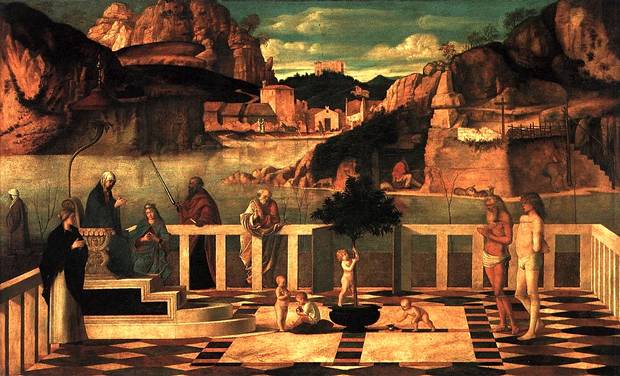One has to admire the Uffizi Gallery’s directors, for managing to keep the museum open over the years it is taking to rearrange it into the ‘Grandi Uffizi’, making use of the space in the building on the first floor and at the same time rehanging some of the historic rooms above. All of this goes on with very little notice in the local press and a dearth of comment generally. Even the information office on the ground floor can hardly keep pace: the free leaflet available at fails to illustrate all of the rooms which you can now visit.

For years the official Room 1, the small room on the right as you enter the first long corridor was closed (or only open on very special request since it displayed ancient Greek and Roman sculpture presumably considered of little interest to the average visitor intent on reaching the Botticelli room as soon as possible). This meant that the visitor itinerary began in Room 2,with the three Maestà altarpieces by Cimabue, Duccio and Giotto. Room 1 was nowhere to be seen.
But just a few weeks ago Room 1 (the sculptures have now moved to Rooms 33 and 34) has been reopened to display the very earliest works in the collection, many of them restored last year, so that one can now understand where the art of Giotto sprang from. The room, now with bright white walls and excellent lighting, is dominated by two Crucifixes, facing each other, both with scenes of the Passion. One dates from c. 1200 or even earlier and the other from c. 1240, and already they clearly demonstrate how medieval art progressed in those years. There are also two panels of a diptych by Bonaventura Berlinghieri of Lucca, who clearly influenced the master of the later Crucifix, and St Francis Receiving the Stigmata, still in its original frame. A very well-preserved painting, which only entered the gallery after its purchase by the Italian state in 2006, is a Madonna and Child Enthroned by the Maestro del Bigallo, named after a work in Florence’s smallest museums (but one of its most enchanting; it is in piazza by the Baptistery). The Madonna Pisa, named after Luigi Pisa who donated it to the gallery in 1933, is a very moving work, as is the serene St Luke the Evangelist displayed beside it by the Maestro della Maddalena. The Redeemer between the Virgin and Three Saints is signed and dated 1271 and preserves its original frame.
At present Room 2 has only the three famous Maestà paintings—and one rather hopes it will stay that way, now that many of the paintings formerly here are re-displayed in Room 1.
Further along the corridor, adjoining the exquisite Tribuna, the next enfilade of rooms (with pretty ceilings decorated in the late 16th century) have been painted white and the works rehung and given good short descriptions, also in English. Room 19 is now devoted to the early Renaissance Sienese School, and the works include a lovely predella by Neroccio dei Landi and a large triptych by Vecchietta.
In Room 20 we skip north to the Veneto, and for the first time Mantegna’s wonderful small triptych with the Adoration of the Magi, Circumcision and Ascension, which preserves its beautiful frame, has been given pride of place against a green panel. But it is in the presence of other masterpieces by him, including the portrait of Cardinal Carlo de’ Medici (also in a magnificent frame) and his tiny Madonna delle Cave. Giovanni Bellini is also very well represented, with three very different works: his mysterious Sacred Allegory, a portrait of a young man (the signature is false so the attribution is also uncertain), and the Lamentation over the Dead Christ, unfinished so left at the chiaroscuro stage. Now fittingly hung here together with works by these two masters are two panels by Antonello da Messina, who worked in Venice for a period and had a great influence on his contemporaries. They were purchased for the gallery in 1996 in accordance with a bequest by Stefano Bardini. They are panels which once belonged to a polyptych and are the only works by Antonello in Florence: stunning paintings on a gold ground, St John the Evangelist and the Madonna and Child (the Madonna has roses in her halo), here displayed to great advantage.
The next three rooms illustrate the art of the regions of the Veneto, Emilia Romagna and Lombardy in the 15th century, and the new arrangement makes comparisons between these painters much more logical, as well as posing questions of reciprocal influences.
So all in all the Uffizi is becoming ever more full of wonderful works, many kept hidden until now in the deposits, and the display is being up-dated to make the visit more and more pleasurable. Note that the telephone booking service (it is always essential to book to avoid the queue) is extremely efficient and quick: and even in late June of this year it was possible to book a visit in the early morning for just a day or two later (T: 055 294883, operational weekdays from 8.30am–6.30pm, and on Saturday 8.30–12.30).
by Alta Macadam. The latest edition of her Blue Guide Florence is available in both print and digital format.






